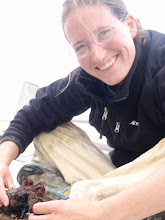 ted inv
ted inv erts in the freezer to see which ones had ice form on them. The coolest one was this flabelligerid polychaete, which got ice crystals forming on the setae (long hairs) and after awhile lifted off the bottom and was swimming/flailing in the water. In this picture, it's moving above an urchin, which is slightly out of focus below it. These are pretty cool worms in general... they're epibenthic, which means they live on top of ("epi") the bottom ("benthic") and have these really long setae. I've seen flabelligerids in Maine and they live in mud and are sort of brown and not particularly attractive, as well as (of course) much smaller than the ones here. I'm not sure what they use the hairs for - deter predators, increase friction while crawling on rocks, etc., but they seem to work pretty well to increase drag and keep the worm suspended in the water. Probably what happens in the real world is the worm lifts off the bottom and gets carried somewhere in the current, hopefully to a better spot without ice. I also noticed that they have bubbles on them and am not sure where the bubbles came from. It sort of squirmed around and did this kind of rough corkscrew-like movement.
erts in the freezer to see which ones had ice form on them. The coolest one was this flabelligerid polychaete, which got ice crystals forming on the setae (long hairs) and after awhile lifted off the bottom and was swimming/flailing in the water. In this picture, it's moving above an urchin, which is slightly out of focus below it. These are pretty cool worms in general... they're epibenthic, which means they live on top of ("epi") the bottom ("benthic") and have these really long setae. I've seen flabelligerids in Maine and they live in mud and are sort of brown and not particularly attractive, as well as (of course) much smaller than the ones here. I'm not sure what they use the hairs for - deter predators, increase friction while crawling on rocks, etc., but they seem to work pretty well to increase drag and keep the worm suspended in the water. Probably what happens in the real world is the worm lifts off the bottom and gets carried somewhere in the current, hopefully to a better spot without ice. I also noticed that they have bubbles on them and am not sure where the bubbles came from. It sort of squirmed around and did this kind of rough corkscrew-like movement.Here's the flabelligerid and a pycnogonid (sea spider), which seemed totally unaffected by ice formation. (The light is my headlamp that I was using to try to get the setae and ice to show up better.)
Today we give our final presentations...

No comments:
Post a Comment